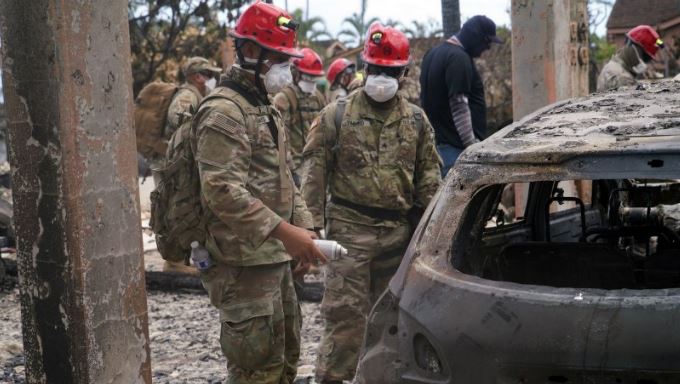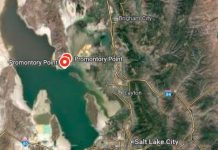
Aug. 15 (UPI) — The death toll in the Hawaii wildfires rose to 99 as of late Monday local time as authorities continued to comb the ashes of West Maui for hundreds of missing people one week after a deadly inferno devastated the island paradise.
Maui Police Department officials said only three of the dead have been identified, while about 25% of the destruction has been searched so far for bodies.
MPD Chief John Pelletier said some family members have identified their own dead after witnessing their final moments, adding the county would begin releasing the identities of those who died on Tuesday.
“Right now we’re at 99 souls, families,” Pelletier said. “We’re going to do this right.”
With more than 1,000 people unaccounted for, FEMA Administrator Deanne Criswell warned “the coming days and weeks are going to be tough.”
During Monday’s White House briefing, Criswell spoke to reporters over live-streamed video from Maui, where she has been the past two days, talking with survivors of what has become the deadliest U.S. wildfire in more than a century.
“Nothing can prepare you for what I saw during my time here and nothing can prepare them for the emotional toll of the impact that this severe event has taken on them,” Criswell said
“The coming days and the weeks, they’re going to be tough. They’re going to be difficult as people process what they have lost and what the road ahead looks like,” she added. “We are going to be with the people of Hawaii, as I have committed to the governor, every step of the way.”
Recovery teams with cadaver dogs are continuing to search the ashes in burned-out homes and cars in the devastated town of Lahaina for human remains with only about “3% of the worst-hit areas” searched, according to Pelletier.
While FEMA has not estimated the cost of the wildfires, Hawaii Gov. Josh Green has placed the cost at about $6 billion and confirmed Monday to CNN that 99 people have died. That number is expected to increase “significantly,” he added.
Criswell said she has been in constant communication with President Joe Biden since the fires started and has spent the last few days meeting with the governor and other officials.
FEMA, which has an office on Oahu, has been in Maui since the fires started. There are currently more than 300 FEMA personnel working to help survivors.
“It’s really far too early to tell what the total cost is going to be,” Criswell said, adding that FEMA workers have served 50,000 meals, 75,000 liters of water and distributed 5,000 cots and 10,000 blankets.
FEMA is also working to get people out of the shelters and into hotel rooms.
“FEMA has activated our transitional sheltering assistance program, which is now available eligible residents who were displaced from their homes. This is FEMA’s hotel program and this will allow them to move from shelters into pre-identified hotels or motels temporarily as they develop their long-term housing strategies.”
Survivors will be given $700 initially for food, water, first aid and medical supplies. There also will be cash assistance for the loss of homes and personal property.
“We’re also focused on getting funds into people’s hands so we can help with some of their critical urgent needs,” Criswell said.
“We are working with our state and local partners to ensure that our outreach and our messaging is also culturally responsive and that we can get messages out to people so they know what is available to them,” Criswell added, saying communication remains extremely difficult as cell service to West Maui is slow to recover.
As of Monday, 19 cell sites serving Kapalu, Napili-Honokawai, Kaanapali, Lahaina, Launiupoko remain out of service with only two restored. A number of wireless companies have sent mobile assets to Maui to support wireless services while fixed cell sites are being repaired, according to the Federal Communications Commission.
“As residents continue to mourn the loss of their friends, their loved ones, their neighbors, the loss of their homes and their way of life, we know and let them know that we are mourning with them,” Criswell added.
The Red Cross is leading reunification efforts, establishing a resource center to find missing persons and collect DNA from survivors to identify the dead.
The county also launched a website at mauinuistrong.info, which offers information on how to donate, volunteer, or provide other support services.
Members of the Salvation Army and Feed My Sheep were on site to coordinate distribution of 1 million pounds of food and supplies that has been donated to thousands of evacuees.
Hawaiian Electric Co. said it restored power Monday to all but 2,000 of the 12,400 customers who lost power in West Maui during the disaster.
Despite more than 300 transformers needing repair, power flickered back at the Lahaina Civic Center, Napili Plaza and other facilities in the region that survived the flames.
Hundreds of electrical workers fanned out across the region in an around-the-clock effort to get homes and businesses reconnected to the grid.
All six emergency shelters on the island, meanwhile, have established internet services for the displaced.
An unsafe water advisory remains in effect.
Green said the state would investigate what he described as “a great deal of water conflict” that has made it difficult for Maui to provide sufficient water to rural areas “for many years.”
“We’re in the process of a comprehensive review that I’ve asked our attorney general to do and there will be multiple reviews at every level to find out what the level of preparedness was,” he said.
At this point, there are no plans for President Biden — who has approved a major disaster declaration for Hawaii — to visit Maui, Criswell said in response to a reporter’s question.
The White House also deflected criticism Monday over President Biden’s beach vacation in Rehoboth, Del., where he offered a “no comment” over the weekend when asked about the rising death toll from the Maui fires.
“You could expect to hear from the president on this issue, clearly it is something that is deeply concerning to him,” White House Press Secretary Karine Jean-Pierre told reporters. “You’ll hear from the president on this. Certainly, he’s the president.”
As of Monday, the fire in and around Lahaina was about 85% contained with more than 2,100 acres burned. More than 2,700 homes and businesses were burned to the ground, leaving more than a thousand residents homeless.
The burned-out historic district of Lahaina remains barricaded, as officials faced ongoing questions over a system of sirens that was not activated after the fires — fueled by heavy winds and drought conditions — erupted Aug. 8.
U.S. Fire Administrator Lori Moore-Merrell, who toured the damage in Lahaina over the weekend, said the wildfire moved “incredibly fast and outpaced anything firefighters could have done.”
The Kula wildfire was 65% contained — 5% more than the previous day — as more than 678 acres have burned, with firefighters still battling hot spots in gulches and other hard to reach places, while also dropping water from the sky.
Another wildfire in the Upcountry area of Pulehu/Kihei was declared 100% contained over the weekend, although fire officials were keeping watch for potential flare-ups.





